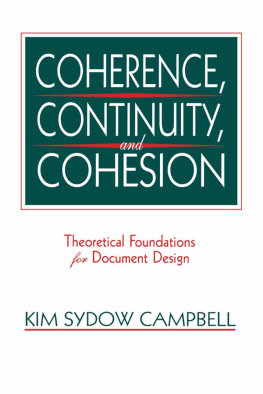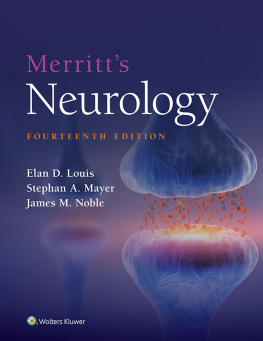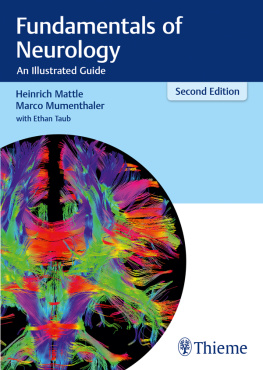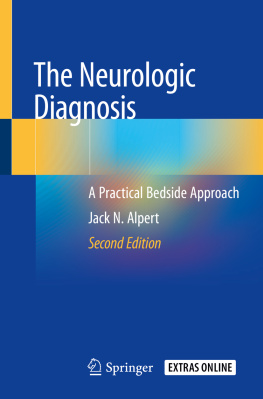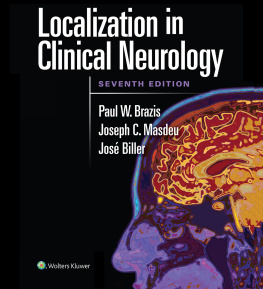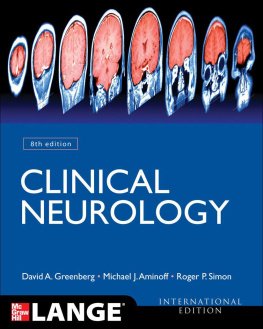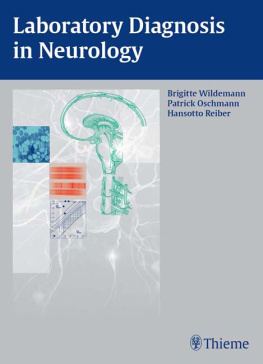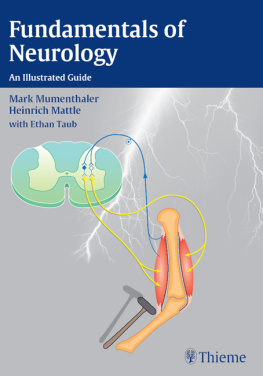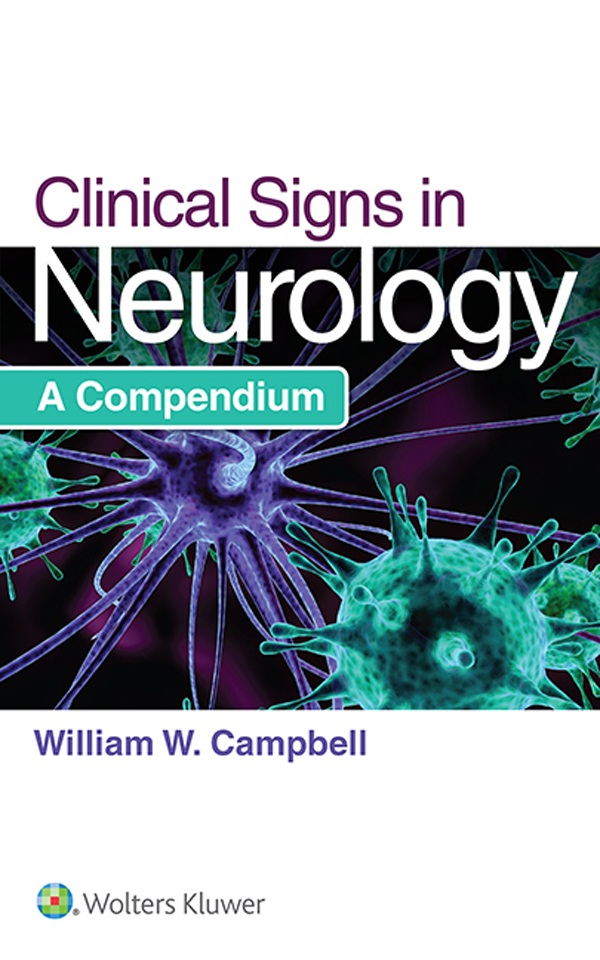
Thank you
for purchasing this e-book.
To receive special offers and news
about our latest products,
sign up below.

Or visit LWW.com



William W. Campbell, MD, MSHA, COL, MC, USA (Ret)
Professor of Neurology (Emeritus)
Uniformed Services University of the Health Sciences
Bethesda, Maryland

Acquisitions Editor: Jamie Elfrank
Product Development Editor: Andrea Vosburgh
Marketing Manager: Stephanie Kindlick
Production Project Manager: Priscilla Crater
Design Coordinator: Elaine Kasmer
Manufacturing Coordinator: Beth Welsh
Prepress Vendor: S4Carlisle Publishing Services
Copyright 2016 Wolters Kluwer.
All rights reserved. This book is protected by copyright. No part of this book may be reproduced or transmitted in any form or by any means, including as photocopies or scanned-in or other electronic copies, or utilized by any information storage and retrieval system without written permission from the copyright owner, except for brief quotations embodied in critical articles and reviews. Materials appearing in this book prepared by individuals as part of their official duties as U.S. government employees are not covered by the above-mentioned copyright. To request permission, please contact Wolters Kluwer at Two Commerce Square, 2001 Market Street, Philadelphia, PA 19103, via email at (products and services).
9 8 7 6 5 4 3 2 1
Library of Congress Cataloging-in-Publication Data
Campbell, William W., Jr. (William Wesley), author.
Clinical signs in neurology : a compendium / William W. Campbell.
p. ; cm.
Includes bibliographical references and index.
ISBN 978-1-4511-9445-6
eISBN 978-1-4963-2814-4
I. Title.
[DNLM: 1. Neurologic ManifestationsHandbooks. 2. Nervous System DiseasesdiagnosisHandbooks. 3. Neurologic ExaminationHandbooks. WL 39]
RC386.6.N48
616.80475dc23
2015021078
This work is provided as is, and the publisher disclaims any and all warranties, express or implied, including any warranties as to accuracy, comprehensiveness, or currency of the content of this work.
This work is no substitute for individual patient assessment based upon healthcare professionals examination of each patient and consideration of, among other things, age, weight, gender, current or prior medical conditions, medication history, laboratory data and other factors unique to the patient. The publisher does not provide medical advice or guidance and this work is merely a reference tool. Healthcare professionals, and not the publisher, are solely responsible for the use of this work including all medical judgments and for any resulting diagnosis and treatments.
Given continuous, rapid advances in medical science and health information, independent professional verification of medical diagnoses, indications, appropriate pharmaceutical selections and dosages, and treatment options should be made and healthcare professionals should consult a variety of sources. When prescribing medication, healthcare professionals are advised to consult the product information sheet (the manufacturers package insert) accompanying each drug to verify, among other things, conditions of use, warnings and side effects and identify any changes in dosage schedule or contraindications, particularly if the medication to be administered is new, infrequently used or has a narrow therapeutic range. To the maximum extent permitted under applicable law, no responsibility is assumed by the publisher for any injury and/or damage to persons or property, as a matter of products liability, negligence law or otherwise, or from any reference to or use by any person of this work.
LWW.com
To the memory of William W. Campbell, Sr.,
Rose Campbell, and Judi Campbell Lee.
And to Rhonda, Wes, Matt, Shannon,
Will, Ella, Sara, and Mitch.
The title of this work evolved through several stages of thought and discussion. The first proposed title was Compendium of Clinical Signs in Neurology. The final title, Clinical Signs in Neurology: A Compendium, was arrived at after the recognition that the term compendium is not currently in wide circulation. It was pointed out that younger physicians might well not be familiar with it. A brief survey of medical students and house staff confirmed the validity of this point of view.
So what is a compendium? One definition is a concise compilation of a body of knowledge. An encyclopedia is a compilation of a body of knowledge that makes little effort to remain concise. This work did not strive for encyclopedia status. The Encyclopedia of the Neurological Sciences runs to four volumes. This book is an attempt at a concise compilation of useful neurologic signs. There was no attempt to include every conceivable neurologic sign, as many are of marginal clinical utility, are primarily of historical interest, and are not in wide use.
This book might be viewed as a Venn diagram of three other works. The first is DeJongs The Neurologic Examination. The DeJong It has been in continuous publication longer than any other major textbook in American neurology. The DeJong makes no attempt at conciseness. Almost every conceivable neurologic sign is at least mentioned, if not discussed in detail, and there is an accompanying discussion of the relevant neuroanatomy, neurophysiology, and clinical neurology. It is not organized in such a way that one can quickly obtain a brief discussion of a given sign. Writing books has made me acutely aware of the limitations of indexing. Even though professional indexers attempt the task, it is distressing how often entities I know are contained in my own book cannot be found in the index.
Enter another influential work: Companion to Clinical Neurology. This book, by William Pryse-Philips, is an alphabetized listing of a host of topics of interest to the neurologist. The Companion might be considered a compendium, as it is at least only one volume, although it is, in its most recent edition, quite a hefty volume. The Companion is not limited to clinical signs and includes a vast amount of information, from the A band to Zellweger syndrome.
The objective of this compendium was to compose an alphabetized, easily accessed, richly illustrated collection limited to clinical signs, and only useful clinical signs. Although some may question whether everything in this collection is truly useful, I think the vast majority are.
The third lattice in the conceptual framework was augenblickdiagnose. This is a German word, obviously, that roughly translates as diagnosis in the blink of an eye. It describes a finding or phenomenon so characteristic that the differential diagnosis is essentially limited to one possibility. The diagnosis is immediately obvious and is rendered in too short a time to have permitted any amount of hypothesis generation and testing. It is familiarity with and recognition of certain physical findings that are so characteristic of a particular condition or clinical syndrome as to permit almost instantaneous diagnosis. A physician familiar with a certain condition that has a characteristic appearance can often recognize it at a glance. It does not even require medical training to recognize something such as Downs syndrome at a glance. A medical student in early clinical training could recognize neurofibromatosis type 1 at a glance. This compendium has attempted to include a large number of figures and videos to illustrate various signs and conditions.
Next page

